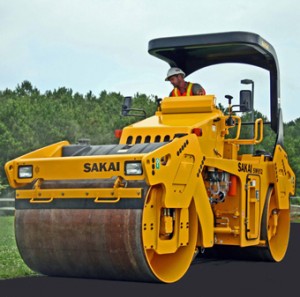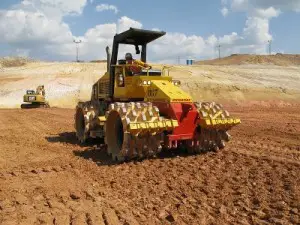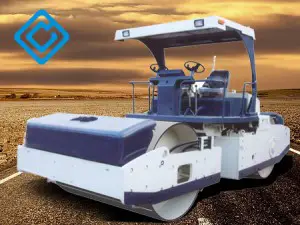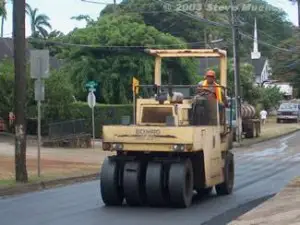Rollers are the construction equipment used for the compaction of soil, gravel, sand, crushed stone layers, etc. Roller working principle is based on vibration, impact loading, kneading and by applying direct pressure on the respective layer. The four most commonly used rollers are;
- Vibratory Roller
- Tamping roller/ sheep foot rolle
- Smooth wheel rollers
- Pneumatic tired roller
Vibratory Roller
Vibratory type rollers have two smooth wheels/ drums plus the vibrators. One is fixed at the front and the other one is on the rear side of vibratory roller. Both wheels/drums are of the same diameter, length and also of same weight. Vibratory roller covers the full area under wheel. To make vibratory roller more efficient, vibrators are also fixed with smooth wheel rollers. Vibration of vibrators arrange the particles by first disturbing even the arranged ones. On the other hand weight of wheels exerts direct pressure on the layer. Vibrators are turned off during the reversed motion of roller. In that time only static weight directly acts on the soil layer.
Vibration is to reduce the air voids and to cause densification of granular soils. During vibration of soil layer, rearrangement of particles occurs due to deformation of the granular soil because of oscillation of the roller in a cycle.
Sheep Foot Roller/ Tamping Roller
Sheep foot roller also named tamping roller. Front steel drum of sheep foot roller consists of many rectangular shaped boots of equal sizes fixed in a hexagonal pattern. Coverage area of sheep foot roller is less i.e., about 8- 12% because of the boots on drums. Sheep foot roller done compaction by static weight and kneading of respective layer. This makes tamping roller better suited for clay soils. Contact pressure of sheep foot roller varies from 1200- 7000Kpa.
Tamping foot roller consists of four wheels and on each wheel kneading boots/feet are fixed. Tamping roller has more coverage area i.e., about 40- 50%. Contact pressure of tamping roller varies from 1400 – 8500KPa. It is best dedicated for fine grained soils.
Smooth Wheel Roller
Smooth wheel roller and vibratory rollers are the same. Both have the same characteristics. Only the difference in both is vibratory equipment. Smooth wheel roller has no vibrator attached with the drum. This makes smooth wheel roller best suited for rolling of weaker aggregates, proof rolling of subgrades and in compacting asphalt pavements. Compaction of clay or sand is not a good choice to done with smooth wheel roller. This is so, because there are many empty voids in clay soil and sand, which cannot be minimized without vibrators.
Pneumatic Tired Roller
Pneumatic tired roller has a number of rubber tires at the front and at the rear end. Empty spaces left in between the two tires that make 80% coverage area under the wheels. Pneumatic roller has the ability to exert contact pressure ranges from 500 – 700Kpa. Pneumatic tired roller can be used for highways, construction of dams and for both fine grained and non-cohesive soils. It is also used for smoothening of finishing bitumen layer on highways, roads, streets etc.





this campany is good to help spftiall by production of som machine continue like this